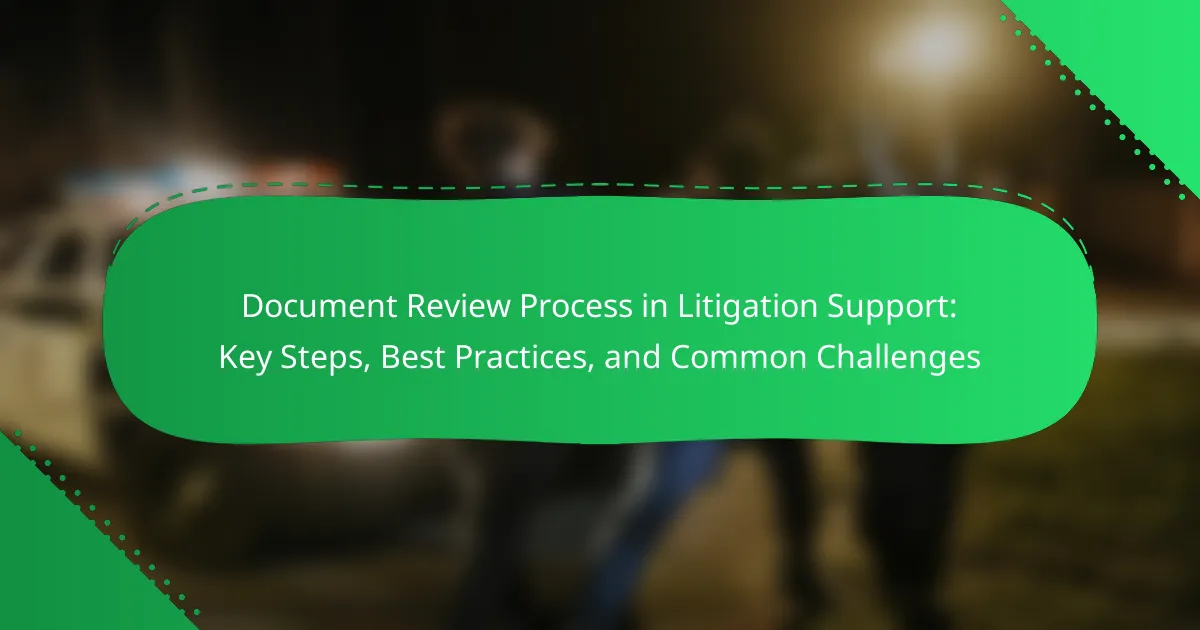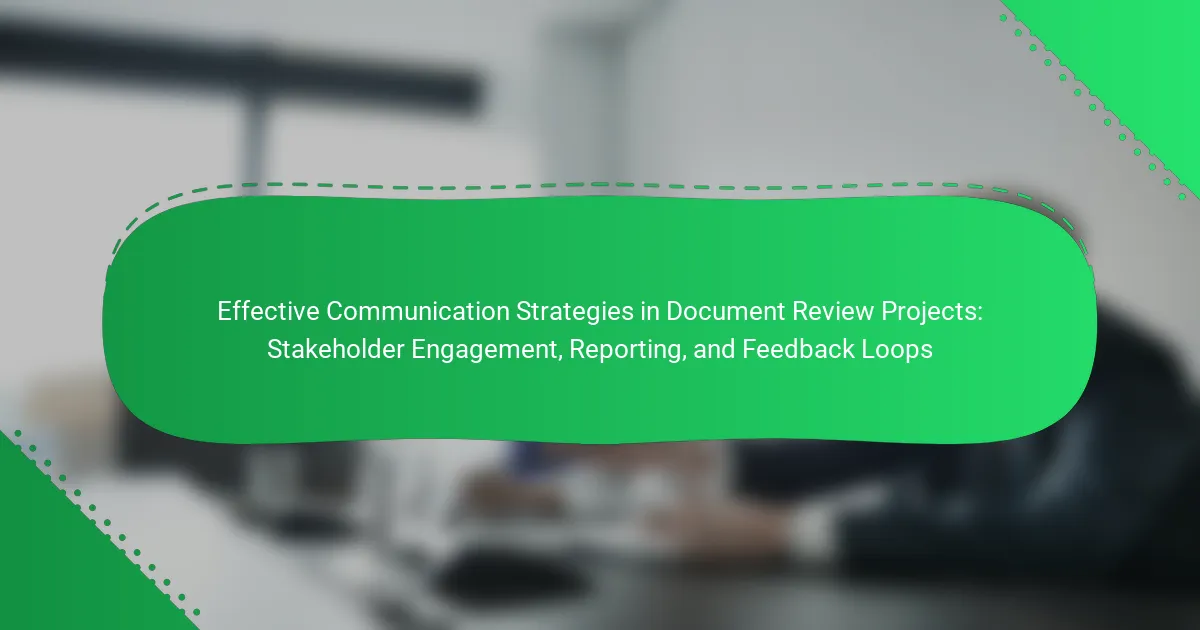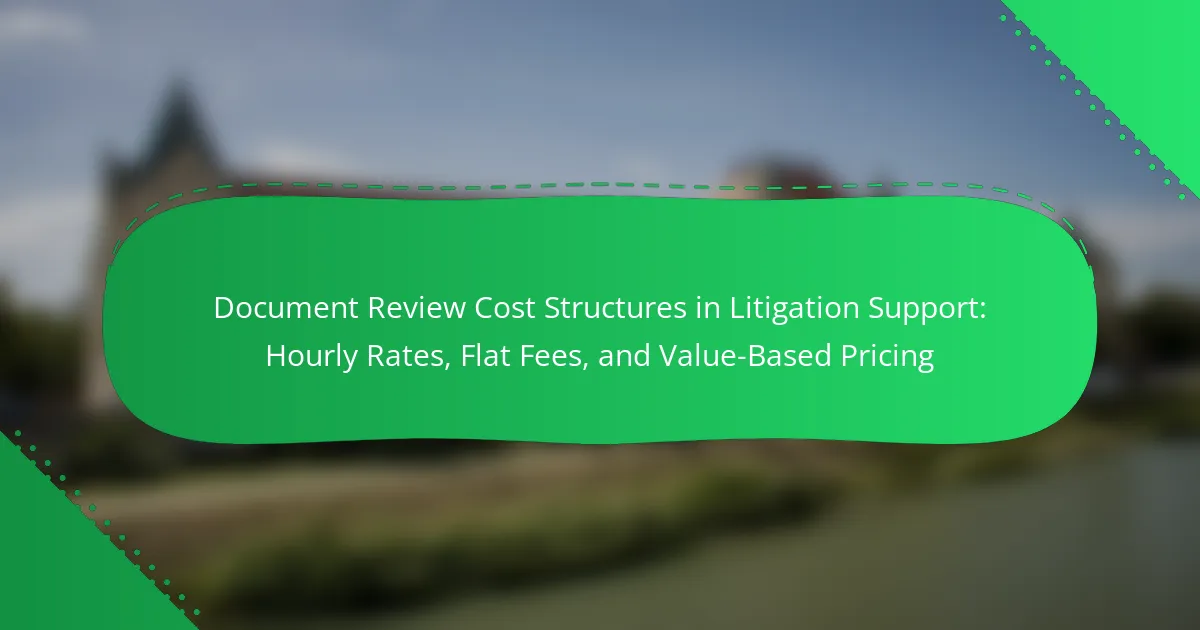The document review process in litigation support is a systematic examination of legal documents to identify relevant information that is essential for building a case or defense. Key steps in this process include preparation, identification, review, analysis, and production of documents, each contributing to a thorough and efficient review. Best practices for conducting document reviews emphasize establishing clear objectives, creating standardized protocols, and leveraging technology to enhance efficiency and accuracy. Common challenges faced in this process involve managing high volumes of documents, ensuring consistent review standards, and addressing time constraints, all while maintaining confidentiality and data security. Understanding these components is crucial for legal teams to effectively navigate the document review process and optimize outcomes in litigation.
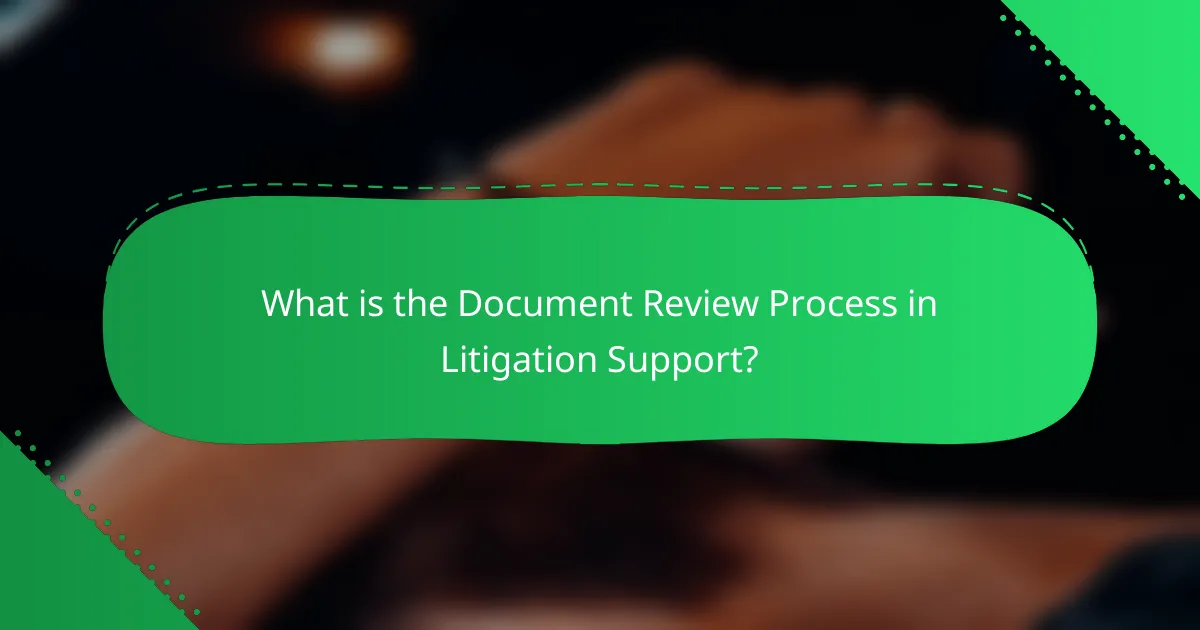
What is the Document Review Process in Litigation Support?
The document review process in litigation support involves systematically examining legal documents to identify relevant information. This process is crucial for building a case or defense. Legal teams typically categorize documents based on relevance and privilege. They use software tools to enhance efficiency and accuracy. Reviewers assess documents for key facts, evidence, and compliance with legal standards. This process can involve multiple iterations and revisions to ensure thoroughness. Effective document review can significantly impact the outcome of a case. Studies show that a well-organized review can reduce costs and time spent on litigation.
How does the Document Review Process fit into the overall litigation process?
The Document Review Process is a critical component of the overall litigation process. It involves the examination and analysis of documents relevant to a legal case. This process ensures that all pertinent information is identified and organized for use in litigation. Effective document review aids in building a case strategy and supports legal arguments. It also helps in compliance with discovery obligations. According to the Federal Rules of Civil Procedure, parties must disclose relevant documents during discovery. The quality of the document review can significantly impact the outcome of a case. A thorough review can uncover key evidence or lead to the identification of weaknesses in the opposing party’s case.
What are the stages involved in the Document Review Process?
The stages involved in the Document Review Process include initial assessment, document collection, document review, quality control, and final production.
Initial assessment identifies the scope and objectives of the review. Document collection gathers all relevant documents for analysis. Document review involves analyzing documents for relevance and privilege. Quality control ensures accuracy and consistency in the review process. Final production organizes documents for presentation or submission.
These stages are crucial for effective litigation support and compliance with legal standards.
How is technology utilized in the Document Review Process?
Technology is utilized in the Document Review Process through software tools that enhance efficiency and accuracy. These tools include e-discovery platforms that automate the identification and organization of relevant documents. Machine learning algorithms assist in categorizing documents based on content and context. Natural language processing helps in extracting key information from large volumes of text. Additionally, collaboration tools enable real-time communication among team members. These technologies reduce the time spent on manual review and minimize human error. According to a study by the International Legal Technology Association, firms that use technology in document review can reduce costs by up to 30%.
What are the key objectives of the Document Review Process?
The key objectives of the Document Review Process are to ensure accuracy, relevance, and compliance of documents in litigation. This process aims to identify pertinent information that supports legal arguments. It also seeks to eliminate irrelevant or privileged documents from consideration. Additionally, the review process helps in organizing documents for efficient retrieval. By doing so, it enhances the overall effectiveness of legal strategies. Accurate document review can significantly impact case outcomes. The process is guided by established protocols and best practices to maintain integrity and confidentiality.
Why is accuracy important in document review?
Accuracy is crucial in document review because it ensures the integrity of legal proceedings. Errors can lead to misinterpretations of evidence. This may affect case outcomes significantly. High accuracy minimizes the risk of costly mistakes. Inaccurate documents can result in sanctions or loss of credibility. Legal professionals rely on precise information to make informed decisions. Studies show that 70% of litigation errors stem from inaccurate document handling. Therefore, maintaining accuracy is essential for effective litigation support.
How does the Document Review Process contribute to case strategy?
The Document Review Process enhances case strategy by ensuring relevant information is identified and analyzed. It allows legal teams to assess the strengths and weaknesses of their case. Through systematic review, attorneys can uncover key evidence that supports their arguments. This process also helps in anticipating opposing counsel’s strategies. By understanding the documents, legal teams can develop targeted arguments and counterarguments. Additionally, it streamlines the discovery phase, saving time and resources. Effective document review leads to informed decision-making and improved case outcomes.
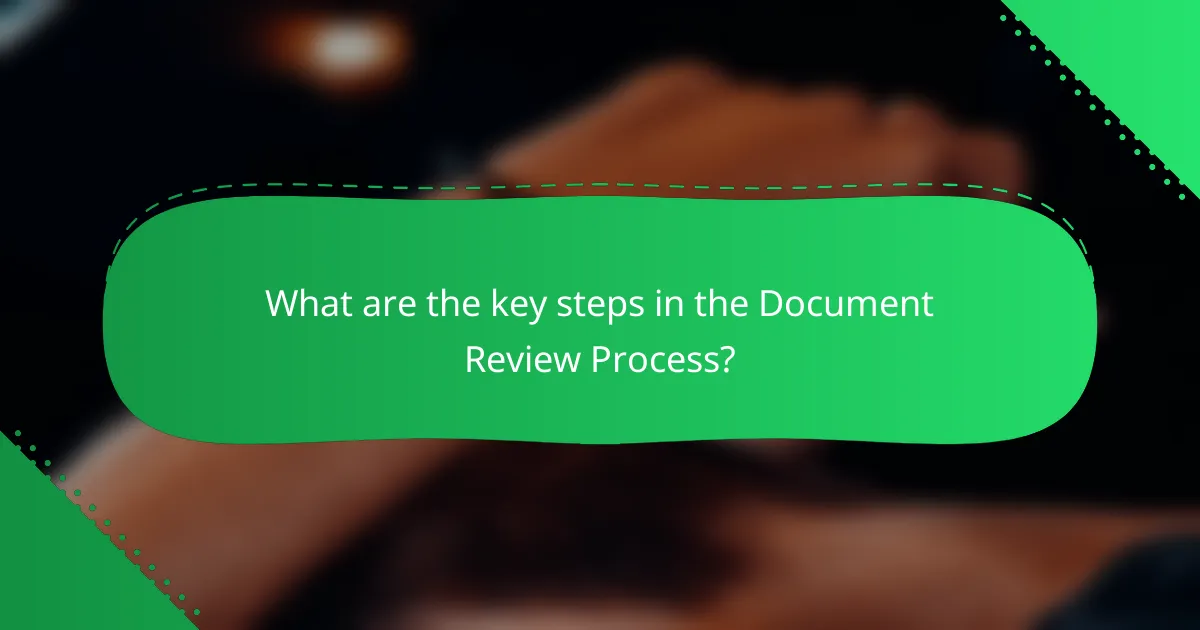
What are the key steps in the Document Review Process?
The key steps in the Document Review Process include preparation, identification, review, analysis, and production. Preparation involves gathering all relevant documents and defining the review criteria. Identification focuses on sorting documents based on relevance and privilege. Review entails examining each document for content, context, and compliance with legal standards. Analysis includes summarizing findings and noting important information. Production consists of organizing and delivering the reviewed documents to relevant parties. These steps ensure a thorough and efficient document review process, crucial in litigation support.
How do you prepare for the Document Review Process?
To prepare for the Document Review Process, gather all relevant documents and information. Organize these documents systematically for easy access. Establish clear criteria for reviewing the documents. This may include identifying key issues, relevant laws, and case specifics. Assemble a team of qualified reviewers with expertise in the subject matter. Provide training to ensure consistency in the review process. Set a timeline for completion to maintain efficiency. Utilize technology, such as document management software, to streamline the review. These steps enhance accuracy and effectiveness in the Document Review Process.
What initial assessments are necessary before document review begins?
Initial assessments necessary before document review begins include identifying the scope of the review. This involves determining the relevant time frame and the specific documents to be reviewed. Assessing the volume of documents is also critical. An accurate estimate of the number of documents helps allocate resources effectively.
Understanding the legal context is essential. This includes identifying applicable laws and regulations that govern the review process. Establishing the objectives of the review is crucial as well. Clear goals guide the entire review process and ensure that it meets legal requirements.
Additionally, assessing technology needs is important. This includes determining whether specialized software is required for document management. Finally, evaluating the team’s expertise is necessary. Ensuring that the team has the required skills enhances the efficiency and effectiveness of the review.
How is a review team selected and trained?
A review team is selected based on specific criteria relevant to the case. These criteria often include legal expertise, familiarity with the subject matter, and prior experience in document review. Team members are typically sourced from legal professionals, paralegals, or specialized review platforms. Training for the review team involves comprehensive instruction on the case specifics and document handling protocols. This training may include guidelines on confidentiality, relevance, and privilege. Additionally, team members are often provided with tools and software training to enhance efficiency. Regular assessments and feedback sessions are implemented to ensure quality and consistency in the review process.
What methodologies are used in the Document Review Process?
The methodologies used in the Document Review Process include linear review, technology-assisted review, and issue-based review. Linear review involves examining documents sequentially, which can be time-consuming. Technology-assisted review employs software tools to identify relevant documents based on keywords and patterns. This method enhances efficiency and accuracy by leveraging algorithms. Issue-based review focuses on specific legal issues, allowing reviewers to concentrate on pertinent documents. Each methodology has distinct advantages and is chosen based on the case’s requirements. The use of technology-assisted review, for example, can reduce review time by up to 60% compared to traditional methods.
What are the differences between linear and technology-assisted review?
Linear review involves a manual examination of documents in a sequential order. Reviewers assess each document one by one without the aid of technology. This method can be time-consuming and labor-intensive. It relies heavily on the expertise of the reviewers.
Technology-assisted review (TAR) uses software tools to enhance the document review process. TAR employs algorithms to prioritize relevant documents for review. This method can significantly reduce the time needed to complete the review. Studies show that TAR can improve accuracy and efficiency in identifying pertinent information.
In summary, linear review is manual and sequential, while technology-assisted review utilizes software to streamline the process.
How do you determine the best methodology for a case?
To determine the best methodology for a case, assess the specific requirements and context of the case. Identify the objectives of the document review process. Evaluate the volume and complexity of the documents involved. Consider the legal standards and guidelines applicable to the case. Analyze the resources available, including technology and personnel. Review past cases with similar characteristics for insights. Engage with stakeholders to gather input on their needs and expectations. This structured approach ensures that the chosen methodology aligns with the case’s unique demands and enhances efficiency.
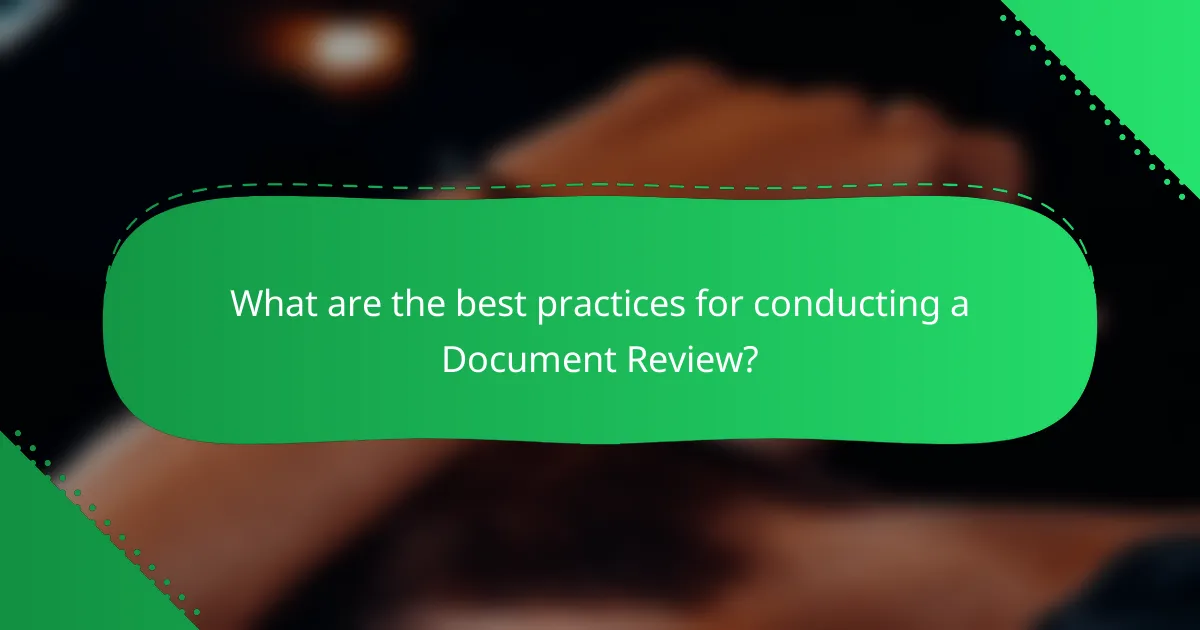
What are the best practices for conducting a Document Review?
The best practices for conducting a document review include establishing clear objectives, creating a review protocol, and utilizing technology effectively. Clear objectives guide the review process and ensure alignment with legal requirements. A review protocol standardizes the process, outlining methods for categorizing and prioritizing documents. Utilizing technology, such as document management systems, enhances efficiency and accuracy. Regular training for reviewers ensures they understand the process and criteria for document relevance. Continuous communication among team members fosters collaboration and addresses issues promptly. Finally, implementing quality control measures helps maintain the integrity of the review process. These practices collectively improve the effectiveness and reliability of document reviews in litigation support.
How can efficiency be maximized during the Document Review Process?
Efficiency can be maximized during the Document Review Process by implementing technology and structured workflows. Utilizing advanced document management software can streamline the organization and retrieval of documents. Automation tools can assist in identifying relevant information quickly. Establishing clear guidelines and criteria for document review ensures consistency among reviewers. Training team members on best practices enhances their efficiency and accuracy. Regularly monitoring progress and adjusting workflows based on feedback can further optimize the process. Studies show that these methods can reduce review time by up to 30%.
What role does project management play in document review?
Project management plays a crucial role in document review by ensuring organization and efficiency. It involves planning, executing, and monitoring the review process. Effective project management helps to define objectives and timelines for document review. It also coordinates team members and allocates resources effectively. Additionally, it establishes clear communication channels among stakeholders. This reduces the risk of errors and omissions during the review. A well-managed project can enhance the quality of the review outcomes. Studies show that structured project management can lead to a 30% increase in productivity during document review processes.
How should communication be managed among team members?
Communication among team members should be managed through clear guidelines and structured channels. Establish regular check-ins to ensure everyone is aligned on tasks. Use collaborative tools like project management software for transparency. Encourage open dialogue to address concerns or questions promptly. Set expectations for response times to enhance accountability. Foster a culture of feedback to improve communication practices. Document discussions and decisions for future reference. These strategies enhance efficiency and reduce misunderstandings in the document review process in litigation support.
What quality control measures should be implemented?
Implementing quality control measures in the document review process is essential for accuracy and efficiency. Key measures include establishing clear review protocols. These protocols ensure consistency in document evaluation. Regular training sessions for reviewers enhance their skills and understanding of standards. Utilizing technology, such as document review software, can streamline the process. Automated quality checks can identify discrepancies and errors quickly. Periodic audits of the review process help maintain high standards. Feedback mechanisms allow reviewers to improve based on performance evaluations. These measures collectively enhance the integrity of the litigation support process.
How can you ensure consistency in document review outcomes?
To ensure consistency in document review outcomes, implement standardized review protocols. Establish clear guidelines for document categorization and evaluation criteria. Train all reviewers on these protocols to align their understanding. Utilize technology, such as document review software, to maintain uniformity in the review process. Regularly audit review outcomes to identify discrepancies and address them promptly. Foster open communication among team members to discuss challenges and share insights. Research shows that teams using standardized processes achieve higher consistency rates in document outcomes.
What are effective ways to handle discrepancies in document review?
Effective ways to handle discrepancies in document review include establishing clear guidelines and communication protocols. First, implement a standardized review checklist to ensure consistency. This checklist should detail specific criteria for document evaluation. Second, encourage open communication among team members to discuss discrepancies as they arise. Regular meetings can facilitate this dialogue. Third, utilize technology tools for version control and tracking changes. Software can help identify and manage discrepancies efficiently. Fourth, designate a point person for resolving disputes. This individual should have the authority to make final decisions on discrepancies. Finally, conduct periodic training sessions to keep the team updated on best practices. These methods enhance accuracy and reduce the likelihood of future discrepancies.
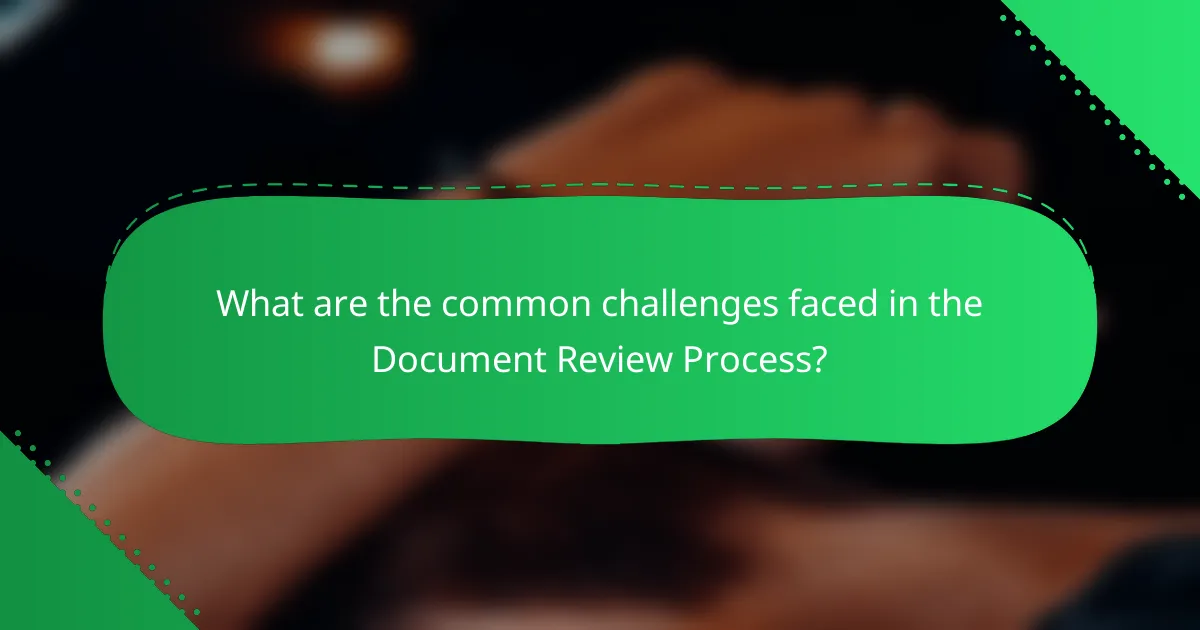
What are the common challenges faced in the Document Review Process?
The common challenges faced in the Document Review Process include high volumes of documents, inconsistent review standards, and time constraints. High volumes can lead to reviewer fatigue, impacting accuracy. Inconsistent standards may result in different interpretations of relevance, causing discrepancies. Time constraints often pressure teams, leading to rushed reviews and potential oversight. Furthermore, managing communication among team members can be difficult, hindering collaboration. Finally, maintaining confidentiality and data security is critical, as breaches can have serious legal implications.
What obstacles may arise during document collection and analysis?
Obstacles during document collection and analysis include data volume, data variability, and legal compliance issues. High data volume can overwhelm resources and delay the review process. Data variability arises from different formats and sources, complicating analysis. Legal compliance issues may arise from privacy laws or regulations, restricting access to certain documents. Additionally, insufficient documentation or incomplete records can hinder thorough analysis. Technical difficulties with software tools can also impede efficient data processing. Lastly, stakeholder disagreements on document relevance can create conflicts and slow progress.
How can data overload impact the Document Review Process?
Data overload can significantly hinder the Document Review Process. It complicates the identification of relevant documents. Reviewers may struggle to sift through excessive information. This can lead to missed critical evidence. Additionally, increased volume requires more time and resources. Teams may experience burnout due to overwhelming workloads. According to a study by the International Legal Technology Association, 60% of legal professionals report data overload as a major challenge. This impacts overall efficiency and accuracy in legal proceedings.
What strategies can mitigate issues related to document relevance?
Implementing a thorough keyword analysis can significantly enhance document relevance. This involves identifying key terms and phrases that are central to the case. Utilizing advanced search functionalities helps in filtering documents based on these keywords. Regularly updating the keyword list ensures it remains aligned with evolving case specifics.
Incorporating machine learning algorithms can also improve relevance assessments. These algorithms analyze past document reviews to identify patterns in relevance. Training models on case-specific data enhances their accuracy over time.
Establishing clear relevance criteria is essential. A well-defined rubric allows reviewers to consistently evaluate documents. This reduces subjectivity in the review process.
Conducting regular training sessions for reviewers ensures they understand the relevance standards. Continuous education helps in maintaining high-quality reviews.
Finally, leveraging collaborative review platforms can increase efficiency. These platforms enable real-time feedback and discussion among team members. This collective input leads to improved document relevance outcomes.
How do legal and ethical considerations affect the Document Review Process?
Legal and ethical considerations significantly impact the Document Review Process. They ensure compliance with laws and regulations during document handling. Legal considerations include adherence to privacy laws, such as the GDPR and HIPAA. Ethical considerations involve maintaining confidentiality and avoiding conflicts of interest. Violations can lead to legal penalties and damage to reputation. Document reviewers must be trained in these areas to mitigate risks. Proper protocols must be established to guide the review process. These protocols help maintain the integrity of the legal proceedings.
What are the implications of confidentiality during document review?
Confidentiality during document review ensures that sensitive information remains protected. Breaches can lead to legal repercussions and loss of trust. Maintaining confidentiality is essential to comply with regulations like GDPR and HIPAA. It safeguards proprietary information and client privacy. In litigation, confidential documents can affect case outcomes if disclosed improperly. Legal teams must implement secure processes to manage document access. Training staff on confidentiality protocols is crucial for compliance. Overall, confidentiality is a foundational element of the document review process.
How can compliance with legal standards be ensured?
Compliance with legal standards can be ensured through systematic adherence to established guidelines. Organizations must implement comprehensive training programs for staff on legal requirements. Regular audits and assessments of processes can identify compliance gaps. Utilizing technology for document management enhances accuracy and efficiency. Collaboration with legal experts ensures alignment with current laws. Maintaining detailed records of compliance efforts provides accountability. Regular updates on legal changes keep practices current. Following these steps minimizes the risk of non-compliance.
What practical tips can improve the Document Review Process?
Implementing a structured workflow can significantly improve the Document Review Process. Establish clear roles for team members to enhance accountability. Utilize technology, such as document management systems, to streamline access and organization. Set specific deadlines for each phase of the review to maintain momentum. Regularly conduct training sessions to keep the team updated on best practices and tools. Encourage open communication among reviewers to address questions and concerns promptly. Monitor progress through metrics to identify bottlenecks and areas for improvement. These strategies can lead to a more efficient and effective document review process.
The main entity of this article is the Document Review Process in Litigation Support. This process involves systematically examining legal documents to identify relevant information, which is essential for building effective legal cases. The article outlines key steps such as initial assessment, document collection, review, and production, while also discussing best practices to enhance accuracy and efficiency. Additionally, it addresses common challenges faced during document review, including data overload and compliance with legal standards, providing practical tips to mitigate these issues and improve overall outcomes.
